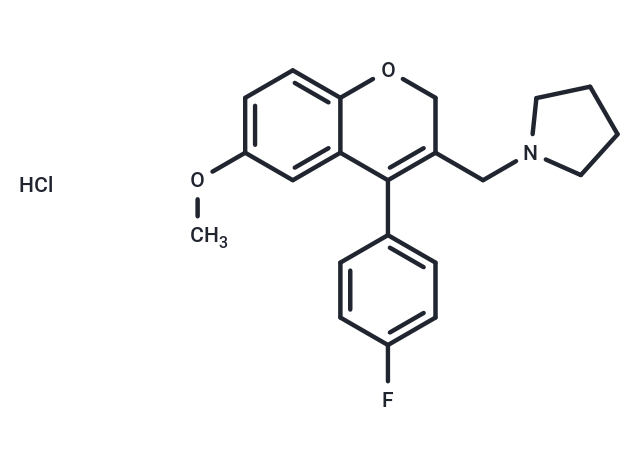Shopping Cart
Remove All Your shopping cart is currently empty
Your shopping cart is currently empty
AX-024 hydrochloride (AX-024 HCl) is an cytokine release inhibitor which can strongly inhibit the production of interleukin-6 (IL-6), tumor necrosis factor-α (TNFα), interferon-γ (IFN-γ), IL-10 and IL-17A.

| Pack Size | Price | USA Warehouse | Global Warehouse | Quantity |
|---|---|---|---|---|
| 2 mg | $30 | In Stock | In Stock | |
| 5 mg | $48 | In Stock | In Stock | |
| 10 mg | $73 | In Stock | In Stock | |
| 25 mg | $156 | In Stock | In Stock | |
| 50 mg | $289 | In Stock | In Stock | |
| 100 mg | $538 | In Stock | In Stock | |
| 200 mg | $766 | - | In Stock | |
| 1 mL x 10 mM (in DMSO) | $53 | In Stock | In Stock |
| Description | AX-024 hydrochloride (AX-024 HCl) is an cytokine release inhibitor which can strongly inhibit the production of interleukin-6 (IL-6), tumor necrosis factor-α (TNFα), interferon-γ (IFN-γ), IL-10 and IL-17A. |
| In vitro | Compound AX-024 hydrochloride exhibits over 10,000 times greater efficacy than its precursor, AX-000, in inhibiting TCR-triggered T cell proliferation, with an IC50 value of 1 nM and showing effects at concentrations as low as 1 pM. Additionally, it significantly outperforms AX-000 in suppressing cytokine release from human peripheral blood mononuclear cells activated with anti-CD3, effectively reducing the production of IL-6, TNFα, IFN-γ, IL-10, and IL-17A at a 10 nM concentration. In OT1 TCR transgenic (OT1Tg) mice with wild-type (WT) cells, AX-024 hydrochloride robustly inhibits T cell proliferation at a 0.1 nM concentration when the OT1Tg T cells are WT for the PRS mutation. Furthermore, coimmunoprecipitation experiments have demonstrated that Nck recruitment to the TCR is blocked by AX-024 hydrochloride in a concentration-dependent manner starting at 1 nM, indicating the compound's potent inhibitory action on T cell activation processes. |
| In vivo | Treatment with AX-024 hydrochloride results in a significant reduction of scales and skin thickening when compared to the vehicle-treated group, demonstrating particular effectiveness in diminishing the thickening of the dermis to levels akin to those observed in mice treated with a control cream without imiquimod (IMQ). Additionally, administration of AX-024 hydrochloride notably reduces the number of airway inflammatory cells and facilitates rapid recovery from neurological impairment and weight loss in mice. By day 30, mice treated with AX-024 hydrochloride become symptom-free, contrasting sharply with vehicle-treated mice, which continue to exhibit symptoms such as ataxia and loss of the righting reflex. |
| Cell Research | Spleen B cells from C57BL/6 mice are labeled with Cell Trace Violet and incubated for 72 hours with either anti-IgM (10 mg/mL) or anti-CD40 (5 mg/mL), supplemented with IL-4 (5 ng/mL) or LPS (2.5 mg/mL) in the presence of different concentrations of AX-024 hydrochloride. Proliferation is calculated according to the total number of cell divisions. They are for reference only. |
| Animal Research | Eight-week-old CD-1 mice are injected intraperitoneally with different amounts of the AX-024 hydrochloride dissolved in 0.5 mL of saline. All animals are observed Clinically for the appearance of macroscopically visible adverse reactions twice daily over 14 days, as well as immediately after AX-024 hydrochloride administration. A necropsy is carried out on each animal on day 14, and the abdominal, thoracic, and cranial cavities are examined in situ, together with their associated organs. They are for reference only. |
| Synonyms | AX-024 HCl |
| Molecular Weight | 375.87 |
| Formula | C21H23ClFNO2 |
| Cas No. | 1704801-24-0 |
| Smiles | Cl.COc1ccc2OCC(CN3CCCC3)=C(c3ccc(F)cc3)c2c1 |
| Relative Density. | no data available |
| Storage | Powder: -20°C for 3 years | In solvent: -80°C for 1 year | Shipping with blue ice/Shipping at ambient temperature. | |||||||||||||||||||||||||||||||||||
| Solubility Information | DMSO: 45 mg/mL (119.72 mM), Sonication is recommended. | |||||||||||||||||||||||||||||||||||
| In Vivo Formulation | 10% DMSO+40% PEG300+5% Tween-80+45% Saline: 2 mg/mL (5.32 mM), Sonication is recommeded. Please add the solvents sequentially, clarifying the solution as much as possible before adding the next one. Dissolve by heating and/or sonication if necessary. Working solution is recommended to be prepared and used immediately. The formulation provided above is for reference purposes only. In vivo formulations may vary and should be modified based on specific experimental conditions. | |||||||||||||||||||||||||||||||||||
Solution Preparation Table | ||||||||||||||||||||||||||||||||||||
DMSO
| ||||||||||||||||||||||||||||||||||||
| Size | Quantity | Unit Price | Amount | Operation |
|---|

Copyright © 2015-2025 TargetMol Chemicals Inc. All Rights Reserved.